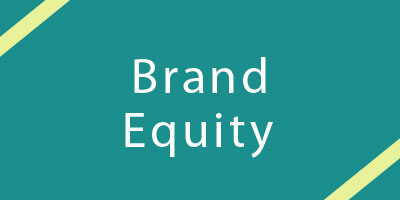Brand Equity
Brand equity is a measure of brand's worth. It can be expressed concisely in a few sentences; by its elements of value as perceived by the consumers, by its dominant characteristics, by its popularity, by its credibility factors, by its revenue potential and also by the price anybody would wish to buy it at for all its values. Brand equity is the power of a brand to make good in the market.Unbiased assessment of Brand equity is critical for deciding on the next-steps in marketing and the approach to work with it. For achieving operational efficiencies it is important to balance the marketing decisions and promotion inputs with the true value and potential of the brand. A good understanding of Brand equity helps fine-tune and reset demand drives in enhancing the potential of the brand.
Brand equity determines feasibility level of business strategies, market expansion programs and brand extensions. It sets the prices and impacts trade terms. Powerful brand equity helps cut through competition and provides the resilience to endure market upheavals. Brand equity is a certain potential apart from the enterprise and can be leveraged for business advantages and valued in money terms.
Brand Equity Articulation
Brand Equity Articulation (BEa) is a structured write-up - presenting the true potential of a brand as at the given time. It is a compact document but with highly descriptive statements and notes on the value perspectives duly supplemented with illustrative chart and maps. It is unbiased, candid and authoritative in putting out positive as well as negative value elements.The task involves assessment of brand equity across the value factors. It includes products, competencies, communications and most importantly consumers' perceptions of them.
The document portrays the brand's real personality traits, style and attitude. It describes the brands capabilities and limits as against the market opportunities and competition situation. It evaluates the brand equity quotient with that of the competition. It serves as a fundamental document for developing the next branding policies and the next set of strategies and programs.
Leveraging Brand Equity
A good understanding of the brand's factors of value, intensity or extent of each of them and their suitable application in operations and business development efforts can result in cost efficiencies and greater effectiveness. Leveraging brand equity is about ensuring appropriateness of strategies, style, attitude and communications across operations and programs - as befitting to the brand's perceived values.Leveraging of values with strategies relate to suitability of conviction and approach. With operations, it is about people and systems and, with programs, it is about style and attitude. Values can be cross leveraged as well for superior benefits and stronger reinforcement of the values.
Inconsistency in anything and behavioral mismatch are classic examples of absence of brand equity on play. Not leveraging on relevant brand values is akin to undermining the very values which, in effect, would only cause erosion of brand equity. Leveraging brand equity leads to optimization of resources that will favorably reflect in the finances and eventually can only add to the brand equity.
Future Scope for the Brand
Future scope for a brand refers to big opportunities that can cause a surge in brand equity or a big increase in its revenue potential - as primary impact. The scope is normally determined by the level of brand equity at the given time. However, certain exceptional opportunities which essentially arise out of an element innovation can even propel a low key but fundamentally fit brand to the centre of competition.Broadly the opportunities are of two types - those that primarily enhance brand equity and those that expand the brand on the strength of brand equity. Branding opportunities help reinforce brand's values or create a new value perspective altogether. Branding opportunities are created - out of research and are of the nature of brilliantly structured programs with innovative elements or are powered by wholesome innovation (refer: Power Charging). Branding opportunities can be researched out of the linkages of brand's value elements.
Brand Opportunities can be within - in the products and systems which are matters of innovation or in the markets which becomes feasible mainly by the power of the brand equity. Usual opportunities in the market are about expanding the market by depth and width (refer Big Leaps). Also, sheer power brand equity provides a brand to opportunity to exploit market situations, economize certain operations and even earn a revenue just out of it.
Brand Equity Valuation
A brand may have to be valued by the money for presenting the brand's value as an asset, for a stake sale, making a public offer of shares or for outright sale. Price that can be got for a brand varies by the way it is packaged and also presented. Nevertheless, a brand is essentially valued by its future potential and therefore pricing a brand is about putting up a bold price and substantiating it with rationale and conviction.In a stake sale or public offer of shares brand equity powers the pricing of the enterprise as whole. Pricing right in such cases calls for skillful articulation of brand equity duly appropriating the future scope and should be backed by communication of the value proposition exceptionally.
The price for a brand is not really sustained by who bids for it but by who should ideally bid for it. Branding a brand for sale is important to be able to get the best price on a sell-out. It calls for; conscious focus on operations, professional planning of the business, research on branding opportunities and of course short term investments in business. It is a task that needs management expertise and superior branding skills - for all the extra money that it can fetch.









